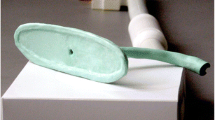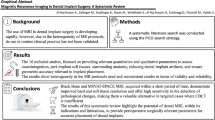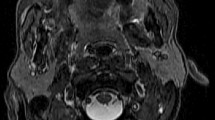Abstract
Purpose
Magnetic resonance imaging (MRI) is widely used in study of maxillofacial structures. While MRI is the modality of choice for soft tissues, it fails to capture hard tissues such as bone and teeth. Virtual dental models, acquired by optical 3D scanners, are becoming more accessible for dental practice and are starting to replace the conventional dental impressions. The goal of this research is to fuse the high-resolution 3D dental models with MRI to enhance the value of imaging for applications where detailed analysis of maxillofacial structures are needed such as patient examination, surgical planning, and modeling.
Methods
A subject-specific dental attachment was digitally designed and 3D printed based on the subject’s face width and dental anatomy. The attachment contained 19 semi-ellipsoidal concavities in predetermined positions where oil-based ellipsoidal fiducial markers were later placed. The MRI was acquired while the subject bit on the dental attachment. The spatial position of the center of mass of each fiducial in the resultant MR Image was calculated by averaging its voxels’ spatial coordinates. The rigid transformation to fuse dental models to MRI was calculated based on the least squares mapping of corresponding fiducials and solved via singular-value decomposition.
Results
The target registration error (TRE) of the proposed fusion process, calculated in a leave-one-fiducial-out fashion, was estimated at 0.49 mm. The results suggest that 6–9 fiducials suffice to achieve a TRE of equal to half the MRI voxel size.
Conclusion
Ellipsoidal oil-based fiducials produce distinguishable intensities in MRI and can be used as registration fiducials. The achieved accuracy of the proposed approach is sufficient to leverage the merged 3D dental models with the MRI data for a finer analysis of the maxillofacial structures where complete geometry models are needed.





Similar content being viewed by others
References
Abdi AH, Hannam AG, Stavness IK, Fels S (2017) Minimizing fiducial localization error using sphere-based registration in jaw tracking. J Biomech 68:120–125
Arun KS, Huang TS, Blostein SD (1987) Least-squares fitting of two 3-D point sets. IEEE Trans Pattern Anal 9(5):698–700
Barone S, Paoli A, Razionale AV (2013) Computer-aided modelling of three-dimensional maxillofacial tissues through multi-modal imaging. Proc Inst Mech Eng 227(2):89–104
Brüllmann D, Schulze RK (2015) Spatial resolution in CBCT machines for dental/maxillofacial applications—what do we know today? Dentomaxillofac Rad 44(1):20140204
Gupta S, Patil N, Solanki J, Singh R, Laller S (2015) Oral implant imaging: a review. MJMS 22(3):7–17
Hack GD, Patzelt SBM (2015) Evaluation of the accuracy of six intraoral scanning devices: an in-vitro investigation. ADA Prof Prod Rev 10(4):1–5
Idiyatullin D, Corum C, Moeller S, Prasad HS, Garwood M, Nixdorf DR (2011) Dental magnetic resonance imaging: making the invisible visible. J Endod 37(6):745–752
Ludwig U, Eisenbeiss AK, Scheifele C, Nelson K, Bock M, Hennig J, von Elverfeldt D, Herdt O, Flügge T, Hövener JB (2016) Dental MRI using wireless intraoral coils. Sci Rep 6(23):301
Marques da Silva AM, Hoffmann EC, Link EG, Trombetta AB, Bacim F, Borges JA (2013) Three-dimensional virtual preoperative implant planning P3Dental using computed tomography images. Springer, Berlin, pp 916–919
Oliveira FPM, Manuel J, Tavares RS (2014) Medical image registration: a review. Comput Methods Biomech Biomed Eng 17(10):73–93
Renne W, Ludlow M, Fryml J, Schurch Z, Mennito A, Kessler R, Lauer A (2017) Evaluation of the accuracy of 7 digital scanners: an invitro analysis based on 3-dimensional comparisons. J Prosthet Dent 118:36–42
Traser L, Flügge TV, Burdumy M, Kamberger R, Richter B, Hassepass F, Korvink JG, Echternach M (2015) A comparison of different methods to generate tooth surface models without applying ionizing radiation for digital 3-dimensional image fusion with magnetic resonance imagingbased data of the head and neck region. J Comput Assist Tomogr 39(6):882–889
Ventura SR, Freitas DR, Ramos IM, Tavares JMRS (2012) Three-dimensional visualization of teeth by magnetic resonance imaging during speech. In: Proceedings of the 2nd international conference on biodental engineering, London, UK
Wittmann W, Wenger T, Zaminer B, Lueth TC (2011) Automatic correction of registration errors in surgical navigation systems. IEEE Trans Biomed Eng 58(10):2922–2930
Yau HT, Yang TJ, Chen YC (2014) Tooth model reconstruction based upon data fusion for orthodontic treatment simulation. Comput Biol Med 48:8–16
Acknowledgements
We would like to thank Dr. David Tobias for his clinical assistance. This research was undertaken, in part, thanks to the funding from the Vanier Scholar award of the Natural Sciences and Engineering Research Council of Canada (NSERC) (Grant No. 201511CGV-360245-271565) to Amir H. Abdi.
Author information
Authors and Affiliations
Corresponding author
Ethics declarations
Conflict of interest
The authors declare that they have no conflict of interest.
Ethical standard
All procedures performed in studies involving human participants were in accordance with the ethical standards of the institutional and/or national research committee and with the 1964 Helsinki Declaration and its later amendments or comparable ethical standards.
Informed consent
Informed consent was obtained from all participants included in the study.
Rights and permissions
About this article
Cite this article
Abdi, A.H., Hannam, A.G. & Fels, S. Fiducial-based fusion of 3D dental models with magnetic resonance imaging. Int J CARS 13, 1109–1115 (2018). https://doi.org/10.1007/s11548-018-1767-x
Received:
Accepted:
Published:
Issue Date:
DOI: https://doi.org/10.1007/s11548-018-1767-x




